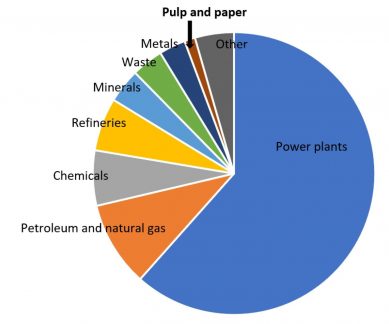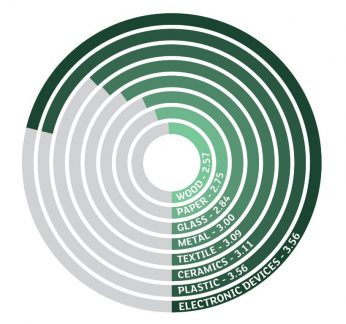
Features
Environment & Sustainability
Paper
Greenhouse gas emissions and climate change: Key facts about paper’s impact
September 19, 2019 By Phil Riebel, Two Sides North America
 Figure 1: U.S. industrial greenhouse gas emissions in 2017 (million metric tons of CO2e)
Figure 1: U.S. industrial greenhouse gas emissions in 2017 (million metric tons of CO2e) The pulp, paper and print industry is one of the lowest contributing industrial sectors to global greenhouse gas (GHG) emissions at only one per cent of emissions worldwide, but consumers don’t know it.
A recent consumer survey commissioned by Two Sides showed a disconnect between consumer perceptions and the facts about the industry’s impact on global GHG emissions. The survey showed that 29 per cent of Americans believe that paper production is a major contributor to global GHG emissions. However, the U.S. pulp and paper sector is one of the lowest emitters of GHG emissions among major U.S. industrial sectors at 1.2 per cent of total U.S. industrial GHG emissions (Figure 1).
Lower GHG emissions
One of the reasons for the relatively low GHG emissions of the forest products industry is its use of renewable fuels. For example, bioenergy use by paper and wood product mills in the U.S. prevents the emission of 181 million metric tons of CO2 equivalents, by merely using waste wood from manufacturing operations. This practice produces the same reduction in GHG emissions as removing about 35 million cars from the road.
In Canada, the forest products industry has made great strides to reduce GHG emissions in production, by cutting the use of coal and cutting oil use by over 90 per cent since the year 2000. In fact, 57 per cent of the industry’s energy use in 2015 was generated by bioenergy.
Forest products also play a key role in global carbon sequestration (absorption) and the mitigation of GHG emissions. As they grow, trees remove CO2 from the atmosphere and they release oxygen, allowing us to breathe and sustain life on the planet. By managing our forests sustainably for the long-term we can ensure that they continue to provide economic, social and environmental benefits, including climate change mitigation. For example, forests in Canada removed 150-160 million tonnes of CO2e from the atmosphere annually (between 2005 and 2016).
Carbon storing
A recent scientific paper has shown that the regeneration of forests through sustainable practices in the paper industry may lead to more carbon sequestration. Globally, younger forests (those growing for less than 140 years) store 1.17-1.66 billion metric tons of carbon per year while old-growth forests sequester 950 million-1.11 billion metric tons.
Forest products like paper continue storing carbon even as a finished product and beyond their life in the forest. It is only if paper is landfilled, burned or left to decay that it begins to release CO2 again. In 2016, forests and wood products in the U.S. captured and stored roughly 10 per cent of all carbon dioxide equivalents emitted by the U.S.
Digital vs. paper
But then why do people assume that going digital is greener? The “hidden” life cycle of our massive electronic infrastructure may be one reason. The fact is that many of us don’t think much about what goes into the manufacture and operation of our computers, smartphones, the energy needed to operate server farms, store massive amounts of digital information, and send emails. It is significant, but largely out of sight and out of mind.
The digital revolution is having a growing impact globally. Let’s explore a few key facts.
The energy consumption required for digital technologies is increasing by nine per cent each year. In fact, the share of digital technology in global GHG emissions could reach eight per cent by 2025, i.e. the current share of car emissions. This is roughly eight times the current share of the pulp, paper and print industries.
The ICT industry and infrastructure still relies heavily on fossil fuels and although it seems harmless to send an email, the world’s emails generate close to 300 million tonnes of CO2, equivalent to the CO2 emissions of over 63 million cars.
This growing environmental impact of “going digital” is not going unnoticed by consumers who were specifically asked to rank several materials and products based on how environmentally friendly they are (Figure 2). Wood and paper ranked at the top and electronics and plastics at the bottom (i.e. having the most environmental impact).
Figure 2: Q: In your opinion, what is the environmental impact of following materials/ products? Please rate from 1 – 5, with 1 being the least environmental impact and 5 being the greatest impact. (Graph shows mean score).
Clearly many people are recognizing some of the unique features of paper such as its renewable raw material and high recycling rate, especially compared to electronics.
The reality is that paper has a great story to tell when it comes to renewable energy use and low GHG emissions compared to other materials. In addition, North America is among the world leaders in sustainable forestry practices, which are vital to reducing our society’s impact on climate change.
Read more about consumer perceptions of the print and paper industry in the Two Sides Busting the Myths reports for the U.S. and Canada.
Phil Riebel is president of Two Sides North America.
This article was reprinted with permission from Two Sides North America. Read the original, including all references, at Two Sides.
Print this page

